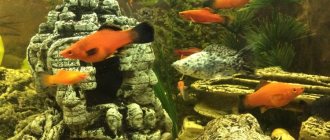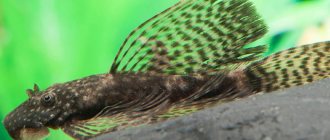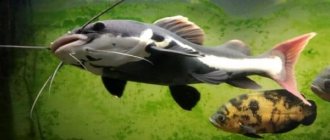- Fight for territory
- Fight for food
- Intraspecific aggression
The origin of the ancitrus is non-predatory, and when the fish begins to behave aggressively, the aquarist has a question: is the ancitrus a predator or not? Of course no. Ancitrus must be fed plant-based food and fed with raw vegetables. And yet, aggressive behavior also occurs among fish of this species. Ancitrus eats fish when it grows large, thus guarding and marking territory.
Features of keeping catfish in an aquarium
The aquarium catfish is an unpretentious pet, whose maintenance will not cause difficulties even for a novice aquarist.
First of all, in order for the fish to develop normally and grow to the required size, it is necessary to purchase a spacious reservoir, otherwise small catfish will grow in the aquarium. The bottom of the container should be wide, since catfish spend most of their lives at the bottom. The size of the aquarium depends on the chosen species - if you plan to buy small catfish, then a volume of 50-100 liters will be sufficient. For large catfish, the minimum dimensions of the reservoir are 300 liters. Water parameters for keeping catfish:
- Temperature – 22-28C.
- Acidity – 6-7.5 pH.
- Hardness – up to 10 dH.
Water changes are performed weekly, updating 25% of the volume. Particular attention should be paid to the cleanliness of the aquarium - despite the fact that catfish help maintain order, pets do not eat garbage and waste, so the owner will have to take care of this.
Lighting for an aquarium with catfish is set to moderate - intense light will cause a lot of inconvenience to pets who prefer to lead a solitary nocturnal lifestyle. A large amount of live vegetation and shelters are placed in the tank so that shade-loving catfish can rest peacefully during the day.
When planting live plants, you should take into account the fact that most catfish are vegetarians and will happily gnaw at underwater flowers. To maintain the design of the tank, you can place artificial algae or the following types of plants:
- cryptocoryne;
- Echinodorus.
They are distinguished by a powerful root system, and can survive the attack of voracious catfish. The soil should be coarse-grained, since in an aquarium catfish happily “pick” in the soil, picking up dirt and debris from the bottom.
Interesting fact: some species of catfish can live up to 100 years in the wild.
Good neighbor, bad neighbor
When selecting fish to stock an aquarium, you need to pay attention to their compatibility with each other. In addition to similar requirements for living conditions (temperature and water hardness, food composition), the character of the fish is of great importance. Peace-loving guppies get along well with representatives of other varieties of aquarium fish. But they themselves often become victims of aggressive neighbors. Guppies' tails are gnawed off, causing the fish to lose the ability to swim normally and soon die.
You can add various types of peaceful aquatic creatures to your guppies.
Pecilia
Viviparous aquarium fish, including several dozen species of different colors. The length of the body is 5-10 cm. The maintenance requirements for platies are similar to guppies because these are representatives of the same family. Does not show aggression towards neighbors.
Danio
Small (up to 8 cm in length) bright representatives of freshwater fauna. They get along well with small peaceful fish species. They prefer animal foods (bloodworms, daphnia), but can also eat plant foods. They are kept in flocks of 5-10 individuals.
Mollies
Also belongs to the Poeciliaceae family. It reaches a length of 13 cm, lives up to 4 years, and is viviparous. Unpretentious. A peaceful but active fish that requires large aquarium volumes (at least 10 liters per head).
Fire barb
Mobile small freshwater fish. Does not cause inconvenience to neighbors if it has enough space to swim freely.
sword bearer
Large and active fish. Predominant colors: red, black, yellowish-green. It gets along well with guppies, provided there is enough free space in the aquarium. In an overpopulated community, it can chase small “goops” and push them away from food.
Ternetia
Unpretentious freshwater fish, not exceeding 6-7 cm in size. For the comfortable existence of thornets, the aquarium needs to be planted with plants (or artificial algae placed). The fish spends most of its time in the thickets. She is not aggressive towards her neighbors.
Catfish
In the same aquarium with guppies, you can safely keep the following types of aquarium catfish: ancistrus (stickers), corydoras, cockroaches. They are modest in size and beautiful in color. Catfish live in the bottom part of the aquarium, so they almost never intersect with fish occupying the upper layers of water. Sometimes a catfish can eat guppy fry if they are in close proximity to it. Even the most harmless fish, and even the parents themselves, are capable of eating fry.
Gourami
Large, but slow and peaceful fish. They get along well with guppies, provided there is enough water.
Tetra
Small, bright fish (neon tetras are especially beautiful) that get along well with other fish in the same vessel.
This is an incomplete list of fish that can be added to the “gupeshkas”. The listed individuals are the most unpretentious and are suitable for beginner aquarists. An excellent neighborhood option for guppies is a species aquarium, in which one or different breeds of guppies can live.
You can keep shrimp and snails in the same aquarium with guppies. Animals have different lifestyles and ways of eating, so they do not interfere with each other.
Nutrition
Feeding catfish is even simpler than keeping them. If your pets live in a tank with other fish, then you don’t have to feed the catfish at all - they will happily pick up leftover food from their neighbors, at the same time cleaning the area. When keeping only catfish fish, you can offer your wards the following products:
- Live and frozen food: bloodworms, tubifex, cyclops, shrimp, etc.
- Catfish tablets and flakes.
- Plant foods: cucumber, spinach, green peas, broccoli, etc.
Before serving, live food must be thoroughly washed, and plant food must be scalded with boiling water. If a predatory catfish lives in the tank, you should remember that small neighbors can become its lunch.
Interesting fact: hungry and predatory catfish living in their natural environment can drag even a dog to the bottom.
Appearance
Ancistrus catfish lives in South America, to be more precise, in mountain reservoirs and tributaries of the Amazon. It came to our country back in the 70s of the last century.
The body of the catfish is covered with a kind of “armor” - bony plates that protect the fish from other underwater inhabitants. Ancistrus leads a bottom-dwelling lifestyle, which directly affected its appearance - its body is teardrop-shaped and slightly flattened. Body size can vary, because in nature there are both small individuals and quite large specimens, the body length of which can reach 20-30 cm in length.
A distinctive feature of Ancistrus is its elongated, suction cup-shaped lips with scrapers that form the lower mouth. With their help, the fish are held on the stones, remaining in place during strong currents. In addition, with the help of these scrapers they eat away plaque from various surfaces (including the walls of the aquarium). It is quite simple to distinguish a male ancistrus from a female - males have a head covered with spines (tentacles), while females do not have them, or they are located on the edge of the head and are smaller in size. But these characteristic features appear only after the fish has reached sexual maturity (at the age of 1-2 years)
The color of individuals can vary - from gray shades to brown or black. The color may fade depending on living conditions.
Compatibility
Most representatives of catfish, due to their friendly and peaceful nature, get along well with their relatives and other aquarium fish. Modest and quiet, catfish do not enter into conflicts or start fights, but with the wrong neighbors they can become victims. Introducing predatory fish, for example, astronotus, into the same aquarium together with catfish can lead to the death of the latter. It is also not recommended to place small and weak fish - guppies, neons and others - in a tank with predatory catfish, since pets may consider them food.
Interesting fact: the European catfish can weigh up to 400 kg, and is even capable of attacking people.
Basic principles of good neighborhood
Before you run to the pet store to buy new pets, you need to carefully study their maintenance requirements and compatibility with other fish.
- The inhabitants of the same aquarium should have similar requirements for temperature and water hardness, the presence of flow and aeration.
- The type of food the fish have should be similar.
- Do not add overly active fish to calm and slow-moving individuals. The latter will become a constant source of stress for sedentary fish.
- The size of the fish should not differ significantly. Large individuals will inevitably begin to oppress the small ones and deprive them of food.
- It is advisable to introduce all inhabitants into the aquarium at the same time. Otherwise, the old inhabitants of the vessel may drive out the newcomers.
- It is necessary to pay attention to the volume of the aquarium without overcrowding it. The minimum volume of water per guppy is 2.5 liters, but it is better to stick to a volume of 5-7 liters per head.
- The fish house should have enough live or artificial plants, pebbles, and driftwood. Small fish, including guppies, love to hide there to rest.
Thanks to the wide variety of guppy breeds, the species aquarium with them looks rich and bright
Among aquarium fish there are enough individuals that can share the same home with guppies. But an aquarium inhabited by only one species of fish will look no less colorful.
Reproduction
Reproduction of catfish at home requires the construction of a spawning tank - a separate container with a volume of 30-70 liters. Having chosen young and strong representatives, the future parents are placed in a spawning tank, and the temperature of the aquatic environment is gradually lowered to 18C to stimulate spawning. It is important not to forget to install an aerator in the nursery and plant living plants. Shelters, snags and grottoes are placed at the bottom.
Before spawning, the wards are intensively fed. Breeding catfish in captivity is an exciting spectacle that has a certain romance. First, the male fish demonstrates beautiful courtship of the lady of his heart: circling around, delicately touching her with his antennae. Having interested the lady, the catfish invites her to the prepared corner for further reproduction. Spawning of catfish lasts 3-4 hours, and during this time the female lays up to 200 large eggs. After hatching, the parents are returned to the old aquarium, and the temperature of the aquatic environment in the spawning tank is increased to 27-28C.
Catfish fry mature in about 5-6 days, after which tiny babies with a yolk sac are born. During the first week of life, the fry gradually mature and begin to explore the waters in search of food. During this period, babies can already be fed with crushed food.
Aquarium catfish are not only charming and friendly pets that stand out from other residents in their appearance and lifestyle, but they are also one of the most unpretentious fish. Keeping catfish in captivity is easy, and even novice aquarists can do it, but before purchasing representatives of the catfish family, you should find out the individual preferences of the chosen variety.
Ancistrus catfish: maintenance and care
Ancistrus adapt well to various conditions, but this does not mean that it is not necessary to follow the basic rules of their maintenance. The recommendations are quite standard, but they must be taken into account in order for catfish to live as long as possible.
The volume of the aquarium must be at least 50 liters. These fish live mainly near the bottom, so the soil should not have sharp edges. It is advisable to use natural driftwood in the aquarium - they are a source of cellulose, which is vital for ancistrus. You should also use live flora, which will not only provide shelter for them, but also provide useful feeding.
In natural reservoirs they live in water with weak acidity, but catfish are able to adapt to much harsher conditions. In particular, they can live in alkaline and hard water.
Good aeration is a prerequisite. Ancistrus live near the bottom, where the concentration of oxygen is low, so if there is not enough aeration, they will begin to swim closer to the surface of the water, which does not have the best effect on them.
The optimal water temperature is from 22 to 24 degrees Celsius. This is explained by the fact that they live in fairly cool waters, so it is recommended to adhere to these values.
Lampoglazik, Kühl's acanthophthalmus, corydoras
Lampoglazik also belongs to the order Poeciliaceae. It is not very popular as an aquarium fish. Guppies and lampeyes can live in the same aquarium, because... both of these species are peaceful. In some cases, lampeyes can eat their relatives.
Acantophthalmus Kühl's appearance resembles a snake. Prefers to live near the bottom. These fish gather in schools. Alone they become shy. In their natural environment, being inhabitants of the water depths, they can reach a length of 10 cm. The peak of their activity occurs at night, while other fish prefer a diurnal lifestyle.
Corydoras catfish are peaceful in nature. They prefer to live at depth, unlike poeciliid fish. These 2 species of fish do not contact each other, each of them leads a characteristic way of life. Corridors easily adapt to different environmental conditions.
Aquarium catfish
Aquarists love catfish for their unusual appearance, the ability of some species to grow to impressive sizes, as well as their decorative properties. There are incredibly many species of aquarium catfish, some of them even vaguely resemble catfish. There are species that completely change our understanding of catfish, and some that can truly rival any goldfish in the aquarium.
Types of aquarium catfish
- The speckled aquarium catfish is a representative of the armored catfish. Almost all of this family of fish have a calm disposition. The marbled aquarium catfish is compatible with any other species; it prefers to live in schools and in aquariums with sandy soil.
- The red-tailed aquarium catfish is also an ornamental species. This particular species is growing by leaps and bounds. And at the same time, the fish grow to very impressive sizes. Therefore, it is worth keeping them as young individuals. Most often you can find this inhabitant at the bottom of the aquarium, where he prefers to rest.
- The aquarium sucker catfish got its name due to the unusual structure of its mouth. Their correct name is ancitrus. These fish are also the orderlies of your aquarium and are completely unpretentious. This one also loves life at the bottom of the aquarium, is peaceful and will not get along except with cichlids. The cichlids will begin to gnaw the fins of the catfish and thereby harm them.
- The aquarium catfish is a representative of the inhabitants of South Asia; in an aquarium it will grow no longer than 12 cm. Such a fish needs space, therefore an aquarium of at least 100 liters is suitable for it. The aquarium catfish of this species prefers life in the water column, but activity occurs in the dark. It is important for this fish to have a sufficient amount of all kinds of decorations and snags on the bottom.
- The tiger aquarium catfish is also called the tiger pseudoplatistoma. When getting these fish, be prepared for their timid nature, which sweeps away everything in its path. The fish will grow large, so it immediately needs a large aquarium, so for an adult pair you need about 1000 liters. According to the size, it is advisable to cover the bottom with large stones or pebbles. If possible, do not introduce timid creatures of similar disposition to this species, as this will only increase the fear.
- The aquarium catfish, by its name alone, arouses the interest of any aquarist. They got their name from their cute and mustachioed face. This species is unpretentious in food, but the quality of water plays an important role. Therefore, constant filtration, aeration and water replacement are mandatory conditions.
- Aquarium striped catfish or the so-called singing catfish. Along the entire body of the fish there are wide bright stripes of white and black colors. This representative of the armored carp boasts incredibly strong armor in the form of bone growths on the body. In addition to their strength, these growths have small spikes, which gives the fish excellent protection.
- The spotted aquarium catfish or cuckoo catfish is a representative of the inhabitants of Africa. The species got its name for a reason: after spawning, the fish act exactly like the well-known bird. The fish are incredibly active and can chase each other in the water for hours.
- The shark aquarium catfish quite rightly got its name, since it looks like a killer whale, but only in miniature. Pangasius, the second name for the aquarium shark catfish, has a flat head shape, as well as two pairs of whiskers and fins, very reminiscent of a shark. The fish is quite nimble, but also very shy. To keep an aquarium catfish you will need an aquarium of at least 300 liters. It is very good if the bottom is decorated with a lot of all kinds of snags and shelters for fish.
Compatibility of catfish
Basically, catfish are peaceful, do not get into fights with other aquarium fish, and sometimes there are conflicts among themselves.
It happens that even a stronger catfish begins to chase the weaker one, and, alas, kills him.
But this is extremely rare. The compatibility of catfish with other fish depends on the type of catfish.
Peace-loving, herbivorous animals need to be matched with non-aggressive neighbors. And for predators - larger fish that can fend for themselves.
Reproduction and breeding
The breeding process for catfish is quite simple, and if you only have fish of this species in your aquarium, you don’t even have to put them in a separate aquarium. Otherwise, for catfish spawning, it is better to allocate a container with clean water with a capacity of 30 to 50 liters. Usually there are 3-4 males per female. It is very desirable that in the place where the spawning takes place there is a lot of algae and soft soil.
If you want to encourage your pets to reproduce, you need to change the water temperature within a few days within 17-25 ° C and aerate the aquarium. Spawning usually occurs early in the morning. When the eggs have already been laid, you can leave natural light or darken it a little. A week after spawning, the female will be ready for a new spawning. The fry develop quite quickly and almost immediately they can be fed with finely chopped bloodworms or “dust”.
Feeding
Feeding catfish is very easy. They eat up the fish food that lies on the bottom, thereby cleaning the bottom of the aquarium. They eat almost everything: pieces of fish, shrimp, tablets, frozen food, cereal, and since most catfish are predators, they can eat small fish in an aquarium, perceiving them as food.
Drawing a conclusion, we can say that catfish in an aquarium are the right fish. Unpretentious and does not require additional care, resistant to various diseases, and, well, very original and beautiful. Having a catfish, your aquarium will always look unique, and you will always be able to rejoice and enjoy the beauty of your pet.
In the following articles you will be able to find the most necessary information about the maintenance of aquarium catfish, the species that interest you, the variety of aquarium catfish, feeding, care, as well as tables of compatibility of catfish with other inhabitants of the aquarium.
"Orphans" of the aquarium
You can often hear from pet store sellers that small and large catfish clean the water in the aquarium and the owner does not have to do this. Catfish, combing the soil at the bottom, actually pick up everything edible, partially cleaning the pollution. By the way, this does not mean that your pet’s nutrition should be left to chance.
It is also important to note that the natural habitat of these fish is silted water. But this also does not mean that you can not clean the aquarium at all and only change the water occasionally. Increased aeration of the water is really not necessary, and clean water and an aquarium are the key to the health of your fish. If you also have other fish, they simply need cleanliness, and the catfish will quickly get used to it and will not experience any inconvenience.
General information about catfish
All types of aquarium catfish, of which there are a huge number in nature, are surprisingly similar in appearance. More than 1,200 thousand different waterfowl variations of this species live in aquariums alone. Otherwise, these fish are called cleaners, because they eat the remains of half-eaten, rotting food lying on the bottom.
And many amateurs purchase such “orderlies” precisely because of their accuracy. You can buy such interesting specimens at any pet store. These aquarium fish, instead of scales, have a lamellar covering consisting of bone tissue. This feature distinguishes them from other waterfowl. Catfish mainly live at the bottom of glass reservoirs and are active only at night. They feed on plant foods, but sometimes they do not hesitate to feast on the leftovers “from the master’s bottom table.”
Catfish are very popular among aquarists, so the demand for them is very high. They buy carapaces because they are: quite peaceful; feel excellent in water at temperatures from 18° +25°C; adapted to hard water; They feel confident with its average acidity with plus/minus deviations in different directions.
Nature has endowed catfish with intestinal respiration. Looking out of the aquarium, they swallow air with their mouths, which is then processed into pure oxygen. If a catfish often lingers near the surface of the water, it means that it is difficult for him to breathe. Aquarium orderlies
CATFISH MOCKED CORRIDORAS CONTENTS BREEDING SPAWNING DESCRIPTION VIDEO PHOTO
PLATIDORAS CONTENTS DESCRIPTION REPRODUCTION PHOTO COMPATIBILITY
PTERYGOPLYCHTHUS BROCADE CONTENTS REPRODUCTION DESCRIPTION PHOTO COMPATIBILITY
GLASS CATFISH CONTENTS DESCRIPTION REPRODUCTION PHOTO COMPATIBILITY.
WHITE-SPOTTED AGAMIXIS CONTENTS REPRODUCTION COMPATIBILITY PHOTO.
Sacbranchial catfish: CONTENTS, COMPATIBILITY, PHOTO, DESCRIPTION.
LORICARY: CONTENTS, COMPATIBILITY, BREEDING, PHOTO, DESCRIPTION.
Do catfish need oxygen?
Catfish are also not demanding on the oxygen regime. They breathe through their skin, so they are able to inhale atmospheric air. In order for a catfish to inhale, it needs to swim to the surface, take in a portion of air and sink to the bottom to use up the collected air.
Be careful, if the catfish is on the surface for a long time, it means it simply does not have enough air. As an exception to an aquarium creature that does not breathe through its skin, Pangasius, the shark catfish, is considered.
Ground and shelters
There are also no special requirements or recommendations for the soil. The soil and shelters must be in the aquarium, since catfish are bottom dwellers. It could be anything: plants, decorative figures or some kind of driftwood, fish houses. If you have plants in an aquarium, pay attention to artificial options, as real catfish will quickly eat them.
If the fish have nowhere to hide and be alone, they will be in a state of stress, their appetite will worsen and its lifespan will be shortened.
Who wouldn't be a good neighbor?
The compatibility of guppies with other fish depends on various factors. Some inexperienced aquarists make the mistake of placing them in the same aquarium with incompatible fish species. These include the following representatives:
- angelfish;
- African and South American cichlids;
- discus;
- goldfish;
- koi carp;
- astronotuses.
Male guppies are distinguished by fluffy tails and fins, and therefore it is not recommended to keep them in the same aquarium with the fire barb and the Sumatran barb, Denisoni. They will pluck the guppy's fins and tails.
Fish that are characterized by aggressive behavior are not suitable as neighbors for poeciliids. In some cases, they cannot be combined with goldfish, cockerel and carp. They pose a danger to guppies because... can eat smaller relatives or take food from them. The constant struggle for survival negatively affects the health of the little guppy, causing it to become stressed.
When purchasing suitable neighbors for this fish, you should take into account their feeding habits. The main factor is preference for temperature conditions and the degree of water hardness. If they do not comply, the fish may die. It is also important to know what fish platies get along with.
Do catfish clean the aquarium?
Surely, sellers in pet stores and friends who own aquarium catfish often told you that these fish clean the aquarium, so you don’t have to do anything additional. This is not entirely true. Catfish actually clean the aquarium, picking up leftover food, food waste or some kind of scales from the bottom. But, if the area of the aquarium is large enough, and there are very few fish, catfish simply will not cope with their task.
This way the fish will be cleaned up as best they can, but you will still have to do the basic cleaning to keep them from dying. It is necessary to purchase a water purification filter to help aquarium residents.











